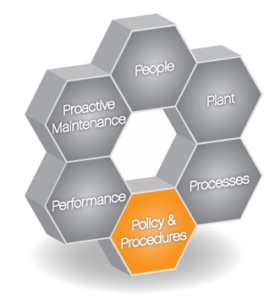Meeting all of the regulatory and compliance requirements
 This article is the 4th in a series of articles. The series documents the continuing journey and quest for a guide to Manufacturing Excellence. The frame we are using to guide or lead us through this journey is the proprietary model called Plant Hexcellence™. As we were discussing in the last issue, the Processes Cell is used to visually map out the flow through a procedure or methodology. We also discussed the connection between the Processes cell and the Policy and Procedures cell.
This article is the 4th in a series of articles. The series documents the continuing journey and quest for a guide to Manufacturing Excellence. The frame we are using to guide or lead us through this journey is the proprietary model called Plant Hexcellence™. As we were discussing in the last issue, the Processes Cell is used to visually map out the flow through a procedure or methodology. We also discussed the connection between the Processes cell and the Policy and Procedures cell.
Turning to the P&P cell, let’s first discuss what is a policy, then about procedures and finally processes and their connectivity in support of the policy.
Certain processes are important enough that the strict adherence to the process is required. It is in my observations with numerous organizations that this is often overlooked. Whether it is regarding spares parts and their direct impact on SOX (Sarbanes-Oxley Act), pressure vessels or any department of labor regulation. The importance of Policy & Procedures is not a priority for most organizations, and it should be.
Traditionally, policies are created and set in place to deal with regulatory compliance, but they can easily be expanded to encompass any process that is deemed critical or and has multiple variables that need to be managed.
DEFINITION:
A Policy is a written and published set of rules, principles or guidelines to create governance. Policies are designed to create a documented standardized behavior or action in specific circumstances. Policies are then supported by Procedures.
Procedures are the specific methods employed to express policies into action in day-to-day operations of the organization. Together, policies and procedures ensure that a point of view/ guideline held by the governing body of an organization is translated into documented steps that result in an outcome compatible with that view.
Let’s discuss a real-world example that is very relevant, and I have usually seen to be absent or lacking within organizations. It will reinforce the connectivity of the Policy-Procedure-Process chain.
Root Cause Failure Analysis (RCA/RCFA)
I have seen in most companies or organization that there is some form of RCFA executed. It is usually around safety / environmental incident investigations but can be very spotty outside of those disciplines. Also, more often than not, Safety and Environmental entities are acting independently with little or no shared method or tools for conducting the investigation (Investigation Optimizer is a great tool to make this work). RCFA can be a very powerful method and tool for identifying and the elimination of failure while understanding the real causal factors around the incident. The issue is that it is done very haphazardly and ad-hoc in timing and methodology. This is especially true for organizations that have multiple sites and have grown through acquisition versus organic growth.
In earlier articles, we discussed the balance required in business to be healthy. There must occur a balance in Safety, Environmental, and Profit. A single RCA/RCFA policy should be written that encompasses all of these elements.
The policy should declare that an RCA/RCFA shall be executed in specific circumstances. (Note: Shall is a word with legal obligation, non-optional in execution)
- Trigger points should be defined
- A Safety incident or near miss
- An Environmental incident or near miss
- Loss of Profit incident
- Loss of revenue greater than X dollars as result of the failure (be sure to include potential fines or contract loss as part of the potential total value)
- Production downtime greater than X as result of the failure (use of this metric is when the cost of downtime is unknown or is in the process of accumulation of WIP (Work in Progress), and therefore there is minimal or no loss in end product revenue)
- Cost of repair greater than X dollars as result of the failure (this must include all manpower and rework)
- There should be two levels for each trigger point so that a less stringent method of RCFA can be used without affecting operations greatly, i.e., 5-Why
- Once the trigger has been activated, then a cross-functional team “must” meet within a specific time frame of the incident (ideally 24 hours or less)
- The RCFA team will have a standard listing of roles that must be in attendance
- Individual names will be listed as to who is qualified to fill that role in that circumstance in writing
- The method of RCFA is listed in the policy
- All personnel that are listed will have had training in the methodology
- A time frame is designated for initial results
- A time frame is designated for final results
- A set procedure and process should be declared on how to document and implement change as result of the findings.
A documented workflow process map should be made to create a visual representation of the method of;
- When to execute a RCFA?
- Method and flow to execute the RCFA? 3. Methods to implement actions as result of the RCFA.
Now the organization has a policy and standard method for understanding:
- What is a RCFA?
- Why execute?
- When to execute?
- Who will execute?
- How to execute?
- Result expectations from the execution
Looking at the example above, It becomes very evident about the inter-connectivity between the Policy-Procedure-Processes chain and how that connectivity can help an organization achieve its goals.
It is of my opinion that the policy and procedure portion of any maintenance, reliability or asset management program are overlooked. Without an overriding policy, an organization may not have the guidance or support required to make the right decisions and drive bottom-line improvements to the organization. While the Policy part may help to demonstrate the support of the senior management, nothing beats having the direct support of the senior leadership (see the ABC’s of Asset Management).
Procedures play the important role of making sure that things are done consistently and correctly. Think of the importance of meter reading and entering into the CMMS. If not done correctly, the hour meters do not operate, and critical PMs may be missed.
The Policy and Procedure cell is vital to the success of any Asset Management program but requires the right forethought and expertise to ensure all vital aspects are covered.
The Plant Hexcellence Model is a proven model that was developed by Scott Kelley at Geometric Reliability but is the model of choice for Eruditio, LLC. If you are interested in the Plant Hexcellence model for your site or organization, please contact [email protected].
Remember, to find success; you must first solve the problem, then achieve the implementation of the solution, and finally sustain winning results.
I’m James Kovacevic
Eruditio, LLC
Where Education Meets Application
Follow @EruditioLLC
References;
- Investigation Optimizer
- Plant Hexcellence Model
- Free PDF Download on Plant Hexcellence – Policy & Procedures
- Scott Kelley
- Geometric Reliability
- Utilizing Policies and Procedures w/ Scott Kelley – Rooted In Reliability
- The Importance of an Asset Management Model – Rooted In Reliability
- The ABC’s of Asset Management – Rooted In Reliability
*This post was originally written by Scott Kelley of Geometric Reliability and modified by James Kovacevic

